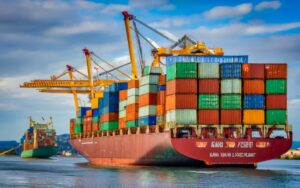China has long been the world’s factory, producing everything from electronics to clothing to furniture. However, in recent years, China’s manufacturing dominance has faced several challenges, such as rising labor and logistics costs, trade tensions with the US and other countries, environmental regulations, and the COVID-19 pandemic. These factors have exposed the fragility and vulnerability of global supply chains that rely heavily on China as a source of raw materials, components, and finished goods.
As a result, many companies are looking for ways to diversify their supply chains and reduce their dependence on China. However, this is not an easy task, as China still offers many advantages, such as economies of scale, skilled workforce, infrastructure, innovation, and market access. Moreover, diversifying supply chains can entail significant costs, risks, and trade-offs, such as finding alternative suppliers, relocating production facilities, complying with different regulations, and maintaining quality and service levels.
Therefore, companies need to carefully assess their risk appetite, their critical partners, their strategic objectives, and their competitive environment before making any decisions on supply chain diversification. They also need to consider the potential scenarios of how the US-China relationship and the global geopolitical landscape will evolve in the next decade, and how that will affect their supply chains and their customers.
In this blog post, we will explore some of the key factors and strategies that companies should consider when diversifying their supply chains away from China, based on insights.
Risk appetite

Risk appetite is the level of risk that an organization is willing to accept in pursuit of its goals. It varies depending on the industry, product, market position, profitability, and competitive situation of each company. For example, a company that produces high-tech products that are of national importance or have military applications may have a lower risk appetite than a company that produces low-value consumer goods.
Risk appetite also determines the level of resilience that a company needs in its supply chain. Resilience is the ability of a supply chain to withstand disruptions and recover quickly. A more resilient supply chain may require more investment in redundancy, flexibility, visibility, and collaboration. However, it may also offer more benefits in terms of customer satisfaction, reputation, and market share.
Therefore, companies need to balance their risk appetite and resilience level when deciding how much to diversify their supply chains away from China. They need to evaluate the likelihood and impact of various risks, such as tariffs, sanctions, lockdowns, natural disasters, cyberattacks, etc., and compare them with the costs and benefits of diversifying their sources of supply.
China manufacturing
Critical partners

Another factor that companies need to consider when diversifying their supply chains is their critical partners. These are the suppliers, customers, distributors, logistics providers, regulators, and other stakeholders that are essential for the success of their business. Companies need to assess the capabilities, reliability, and alignment of their critical partners when deciding where to source from or produce in.
For example, a company may have a strong relationship with a Chinese supplier that offers high-quality products at competitive prices. However, if that supplier is unable to meet the demand due to COVID-19 disruptions or trade restrictions, the company may face delays or cancellations that affect its customer service and profitability. In this case, the company may need to find alternative suppliers in other countries or regions that can provide similar products with comparable quality and price.
Alternatively, a company may have a loyal customer base in China that values its brand and products. However, if the company decides to relocate its production to another country or region due to rising costs or geopolitical risks, it may lose its market access or face higher tariffs or non-tariff barriers in China. In this case, the company may need to maintain some production capacity in China or find ways to mitigate the trade barriers through negotiations or partnerships.
Strategic objectives

A third factor that companies need to consider when diversifying their supply chains is their strategic objectives. These are the long-term goals that guide the direction and priorities of their business. They may include expanding into new markets, innovating new products or services, enhancing operational efficiency, improving sustainability, or increasing shareholder value.
Companies need to align their supply chain diversification decisions with their strategic objectives. They need to evaluate how different sourcing or production locations will affect their ability to achieve their goals. They also need to consider how their decisions will impact their competitive advantage and differentiation in the market.
For example, a company may have a strategic objective of becoming a leader in green technology. However, if it sources most of its materials or components from China, which has a high carbon footprint and environmental impact, it may face criticism or backlash from its customers or regulators. In this case, the company may need to diversify its supply chain to include more suppliers that use renewable energy or follow green practices.
Alternatively, a company may have a strategic objective of entering the Chinese market, which has a large and growing consumer base. However, if it produces most of its products in other countries or regions, which have higher labor or logistics costs, it may face difficulty in competing with local or regional players that offer lower prices or faster delivery. In this case, the company may need to diversify its supply chain to include more production facilities in China or nearby countries that can serve the Chinese market more efficiently and effectively.
China manufacturing
Competitive environment

A fourth factor that companies need to consider when diversifying their supply chains is their competitive environment. This is the external context that influences the performance and behavior of their business. It includes the actions and reactions of their competitors, customers, suppliers, regulators, and other market forces.
Companies need to monitor and anticipate the changes and trends in their competitive environment when deciding how to diversify their supply chains. They need to assess how their decisions will affect their relative position and attractiveness in the market. They also need to consider how their decisions will create or reduce opportunities or threats for their business.
For example, a company may have a competitive advantage in producing high-quality products that meet the standards and preferences of its customers. However, if its competitors start to source from or produce in countries or regions that offer lower costs or higher quality, the company may lose its edge and market share. In this case, the company may need to diversify its supply chain to match or surpass the capabilities and offerings of its competitors.
Alternatively, a company may have a competitive advantage in offering customized products that cater to the specific needs and demands of its customers. However, if its customers start to prefer standardized products that are cheaper or more convenient, the company may lose its relevance and loyalty. In this case, the company may need to diversify its supply chain to adapt or innovate its products to meet the changing preferences and expectations of its customers.
Conclusion
Diversifying supply chains away from China is not a simple or straightforward decision for companies. It requires a careful analysis of various factors, such as risk appetite, critical partners, strategic objectives, and competitive environment. It also involves trade-offs, costs, and risks, as well as opportunities and benefits.
Therefore, companies need to adopt a holistic and strategic approach when considering supply chain diversification. They need to evaluate their current situation and future scenarios, identify their strengths and weaknesses, explore their options and alternatives, and implement their plans and actions. By doing so, they can balance China’s manufacturing dominance with risk mitigation, and achieve resilience and competitiveness in their supply chains.
China manufacturing





